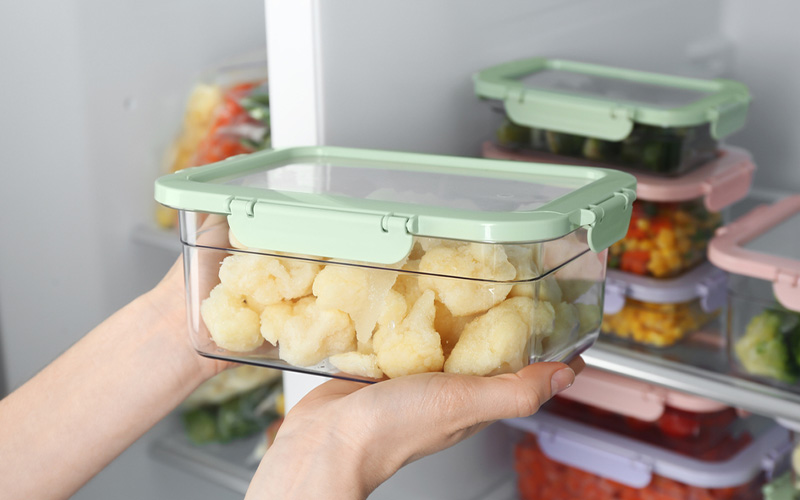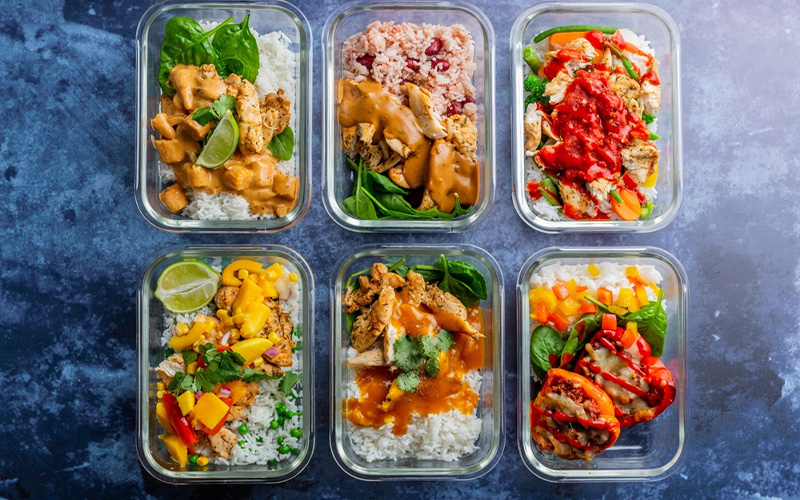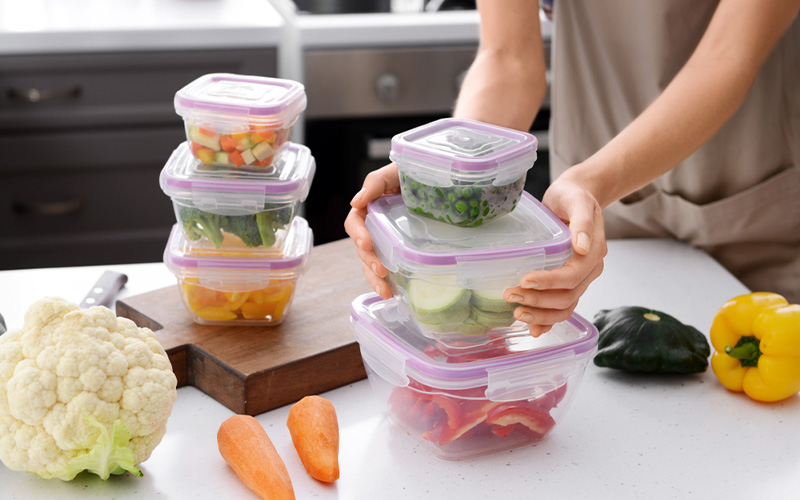
Glass Vs Plastic: Which Food storage Is Best?
Glass and plastic containers are the stalwarts of kitchen storage, offering many choices to keep foodstuffs sealed and preserved.
- Glass, a silica-based hard and brittle material, is often favored for its imperviousness to odors and stains.
- Plastic, a synthetic polymer that's usually more malleable and lightweight, presents a cornucopia of varieties, each with unique characteristics and applications.
Choosing The Right Material For Health And Environment
Selecting the appropriate vessel for edibles is not merely a question of personal preference; it is intrinsically linked to health and ecological sustainability.
Containers made from inappropriate materials can leach toxins, while the environmental burden of production and disposal of these materials can be considerable. Hence, the act of choosing between glass and plastic transcends convenience, tapping into the broader context of wellness.
The Basics Of Food Storage

Preserving the essence, taste, and nutritional value of food necessitates a fundamental understanding of storage requisites. Whether it's preventing moisture loss in refrigerated foods or preventing the ingress of bacteria, the fundamentals of food storage are critical to prolong the edibility and deliciousness of our sustenance.
Read more About Utilizing Aluminum Foil Pans For Take Out And To Go Orders.
Key Features Of Ideal Food Storage Solutions
In pursuing the ideal food storage solution, factors such as
- Airtight seals
- Transparency
- Resistance to temperature fluctuations
- Durability
The ideal container must ensure freshness while being a standard of convenience and safety.
Material: Glass
In the domain of food storage, borosilicate and soda-lime are the predominant glass types, each prized for their resistance to thermal shock and robustness. The former is particularly renowned for its fortitude in the face of sudden temperature changes.
Pros of Using Glass Containers

Glass containers are praised for their
- Non-porous surface
- Precluding the absorption of odors
- Facilitating a purity of taste.
Additionally, their transparency is not only aesthetic but practical, allowing for the effortless identification of contents.
Cons of Using Glass Containers
Despite their virtues, glass containers are not without their drawbacks. Heft and the potential for shattering are chief among them, posing a risk in households with young children or where accidents are prone to occur.
Material: Plastic
The plastic pantheon is vast, with polyethylene terephthalate (PET) and high-density polyethylene (HDPE) among the most universal in food storage. Each type of plastic is distinguished by its characteristics, such as flexibility and chemical resistance.
Pros of Using Plastic Containers

Plastic's lightweight nature and shatter resistance make it a formidable choice for portability and durability. Moreover, the technology has paved the way for BPA-free plastics, which offer a safer alternative for food preservation.
Cons of Using Plastic Containers
Conversely, the propensity for some plastics to harbor chemicals like phthalates and BPA, which can migrate into food, remains a pressing concern. Additionally, scratches and wear can become a nidus for bacteria and impair the plastic's clarity.
Glass As A Non-Reactive Storage Option
Glass, inert by nature, eschews the risk of chemical leachates, thus emerging as the paragon for health-conscious consumers. Its chemical stasis ensures that the only taste is that of the food stored within.
Flavor Preservation
How Glass and Plastic Can Affect the Taste of Food? Interactions at the molecular level between container and contents can have subtle yet perceptible impacts on flavor.
- Glass, with its non-reactive surface, maintains the integrity of the original gustatory profile, while plastic may not always claim the same.
Maintaining The Integrity Of Flavors
To safeguard the sanctity of flavors, glass is the preferred choice, ensuring that the culinary creations remain refined and that the aromas and tastes remain authentic.
Durability And Longevity
When considering the life expectancy of storage containers, glass unequivocally takes the laurels. Resilient to the ravages of time, glass can be the silent guardian in one's kitchen for years, while plastic may succumb to wear more readily.
Scratching, Cracking, And Wear Over Time
The affliction of longevity in plastic containers lies in their susceptibility to scratches and cracks, which can harbor bacteria and compromise the container's integrity. Glass, while not invincible, is often more forgiving of daily wear and tear.
Safety Concerns
Navigating the thermal domains of microwaves and freezers, glass and plastic dance differently. Glass's thermal resilience is typically superior, withstanding temperature alterations without complaint, while some plastics may warp or release chemicals when heated.
Read more About Best Baby Food Containers: An Expert's Buying Guide.
Risk Of Breakage And Its Implications
The Achilles' heel of glass is its brittleness; a careless drop can spell its demise. In scenarios where safety is paramount, such as in the proximity of young children, the risk of breakage is a critical factor to consider.
Environmental Impact
Production footprint analysis reveals that glass manufacturing is energy-intensive, whereas plastic, although less energy-consuming, raises concerns with petroleum dependency and recyclability. Thus, the environmental narrative is complex and nuanced.
Recyclability and Sustainability of Materials
The environmental sustainability in the context of these materials lies in recyclability.
- Glass, infinitely recyclable without loss of purity, stands as a paragon of circular economy principles
- While the recyclability of plastics is fraught with limitations and variability.
Sealing And Leakage
Ensuring the sealed enclosure of foodstuffs, the sealing mechanisms employed in both materials are vital. Silicone gaskets and locking lids feature prominently, with both materials offering robust solutions to keep provisions pristine.
Preventing Leaks And Maintaining Freshness
The battle against the elements and spoilage is won through vigilant sealing. Both materials tout their merits, but it is often the seal's design, rather than the material per se, that dictates the efficacy of containment.
Visibility And Aesthetics
The choice between glass and plastic can influence the visual rhythm of a kitchen. Glass exudes elegance and purity. In contrast, plastic offers practical transparency and a spectrum of design options to match personal style.
Being able to identify at a glance what's inside a container saves time and energy. Glass often offers an unimpeded view. At the same time, plastic, though generally transparent, can become opaque over time due to scratches and wear.
Maintenance And Cleaning
Maintaining food storage containers is paramount for hygiene. Glass triumphs with its dishwasher-friendly and easy-to-clean nature, whereas plastic requires a gentler approach to avoid warping and degradation.
The propensity of materials to resist stains and odors is a testament to their practicality. Glass is naturally resistant to such blemishes. At the same time, plastic, particularly after repeated use, can absorb colors and smells, diminishing its appeal.
Food Preservation Quality
The interplay between container material and food shelf life is subtle yet significant. An airtight seal is paramount, but so is the material's ability to ward off the unforgiving march of time and decay. Glass, often airtight, provides an inert bastion against spoilage, while plastic may struggle with seal integrity over time.
The Role Of Airtight Seals In Preventing Spoilage
An airtight seal is a bulwark against the onslaught of external contaminants and oxidization. Both glass and plastic vie for supremacy in this regard, with innovations in seal technology being a game-changer for prolonging food vitality.
Industry Innovations
The industry is a veritable crucible of innovation, with new materials and designs constantly emerging. From vacuum-sealed glass containers to advanced polymers in plastics, the future of food storage is in a state of exciting flux.
Smart Storage: Technology In Glass And Plastic Containers
Integrating technology, such as freshness indicators and smart lids that track consumption, is revolutionizing how we store and interact with our food. Both glass and plastic are playing pivotal roles in this technological renaissance.


